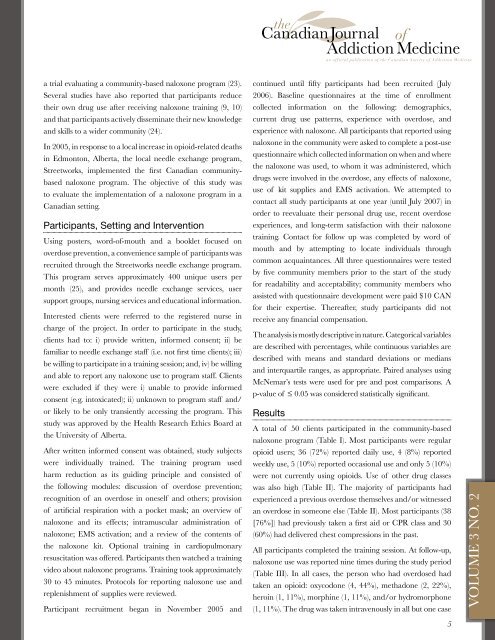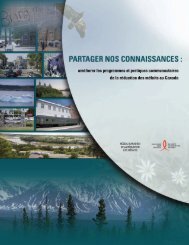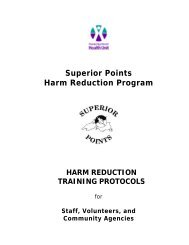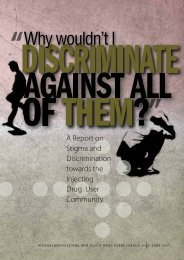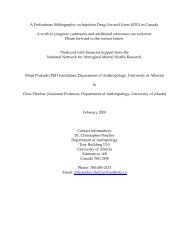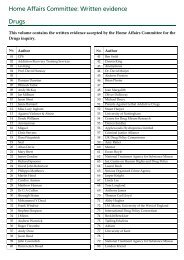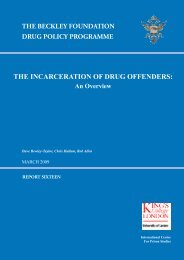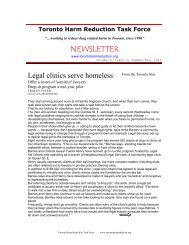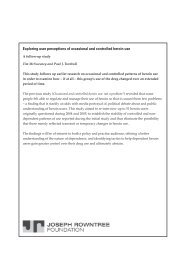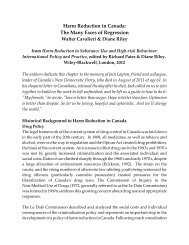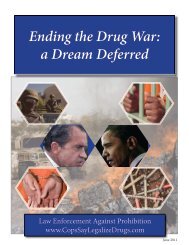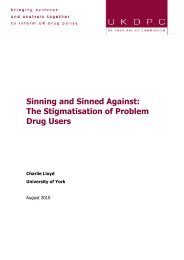Canadian Journal Addiction Medicine - Canadian Harm Reduction ...
Canadian Journal Addiction Medicine - Canadian Harm Reduction ...
Canadian Journal Addiction Medicine - Canadian Harm Reduction ...
You also want an ePaper? Increase the reach of your titles
YUMPU automatically turns print PDFs into web optimized ePapers that Google loves.
the<br />
<strong>Canadian</strong> <strong>Journal</strong> of<br />
<strong>Addiction</strong> <strong>Medicine</strong><br />
an official publication of the <strong>Canadian</strong> Society of <strong>Addiction</strong> <strong>Medicine</strong><br />
a trial evaluating a community-based naloxone program (23).<br />
Several studies have also reported that participants reduce<br />
their own drug use after receiving naloxone training (9, 10)<br />
and that participants actively disseminate their new knowledge<br />
and skills to a wider community (24).<br />
In 2005, in response to a local increase in opioid-related deaths<br />
in Edmonton, Alberta, the local needle exchange program,<br />
Streetworks, implemented the first <strong>Canadian</strong> communitybased<br />
naloxone program. The objective of this study was<br />
to evaluate the implementation of a naloxone program in a<br />
<strong>Canadian</strong> setting.<br />
Participants, Setting and Intervention<br />
Using posters, word-of-mouth and a booklet focused on<br />
overdose prevention, a convenience sample of participants was<br />
recruited through the Streetworks needle exchange program.<br />
This program serves approximately 400 unique users per<br />
month (25), and provides needle exchange services, user<br />
support groups, nursing services and educational information.<br />
Interested clients were referred to the registered nurse in<br />
charge of the project. In order to participate in the study,<br />
clients had to: i) provide written, informed consent; ii) be<br />
familiar to needle exchange staff (i.e. not first time clients); iii)<br />
be willing to participate in a training session; and, iv) be willing<br />
and able to report any naloxone use to program staff. Clients<br />
were excluded if they were i) unable to provide informed<br />
consent (e.g. intoxicated); ii) unknown to program staff and/<br />
or likely to be only transiently accessing the program. This<br />
study was approved by the Health Research Ethics Board at<br />
the University of Alberta.<br />
After written informed consent was obtained, study subjects<br />
were individually trained. The training program used<br />
harm reduction as its guiding principle and consisted of<br />
the following modules: discussion of overdose prevention;<br />
recognition of an overdose in oneself and others; provision<br />
of artificial respiration with a pocket mask; an overview of<br />
naloxone and its effects; intramuscular administration of<br />
naloxone; EMS activation; and a review of the contents of<br />
the naloxone kit. Optional training in cardiopulmonary<br />
resuscitation was offered. Participants then watched a training<br />
video about naloxone programs. Training took approximately<br />
30 to 45 minutes. Protocols for reporting naloxone use and<br />
replenishment of supplies were reviewed.<br />
Participant recruitment began in November 2005 and<br />
continued until fifty participants had been recruited (July<br />
2006). Baseline questionnaires at the time of enrollment<br />
collected information on the following: demographics,<br />
current drug use patterns, experience with overdose, and<br />
experience with naloxone. All participants that reported using<br />
naloxone in the community were asked to complete a post-use<br />
questionnaire which collected information on when and where<br />
the naloxone was used, to whom it was administered, which<br />
drugs were involved in the overdose, any effects of naloxone,<br />
use of kit supplies and EMS activation. We attempted to<br />
contact all study participants at one year (until July 2007) in<br />
order to reevaluate their personal drug use, recent overdose<br />
experiences, and long-term satisfaction with their naloxone<br />
training. Contact for follow up was completed by word of<br />
mouth and by attempting to locate individuals through<br />
common acquaintances. All three questionnaires were tested<br />
by five community members prior to the start of the study<br />
for readability and acceptability; community members who<br />
assisted with questionnaire development were paid $10 CAN<br />
for their expertise. Thereafter, study participants did not<br />
receive any financial compensation.<br />
The analysis is mostly descriptive in nature. Categorical variables<br />
are described with percentages, while continuous variables are<br />
described with means and standard deviations or medians<br />
and interquartile ranges, as appropriate. Paired analyses using<br />
McNemar’s tests were used for pre and post comparisons. A<br />
p-value of ≤ 0.05 was considered statistically significant.<br />
Results<br />
A total of 50 clients participated in the community-based<br />
naloxone program (Table I). Most participants were regular<br />
opioid users; 36 (72%) reported daily use, 4 (8%) reported<br />
weekly use, 5 (10%) reported occasional use and only 5 (10%)<br />
were not currently using opioids. Use of other drug classes<br />
was also high (Table II). The majority of participants had<br />
experienced a previous overdose themselves and/or witnessed<br />
an overdose in someone else (Table II). Most participants (38<br />
[76%]) had previously taken a first aid or CPR class and 30<br />
(60%) had delivered chest compressions in the past.<br />
All participants completed the training session. At follow-up,<br />
naloxone use was reported nine times during the study period<br />
(Table III). In all cases, the person who had overdosed had<br />
taken an opioid: oxycodone (4, 44%), methadone (2, 22%),<br />
heroin (1, 11%), morphine (1, 11%), and/or hydromorphone<br />
(1, 11%). The drug was taken intravenously in all but one case<br />
5<br />
Volume 3 No. 2


